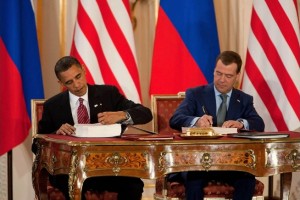 This week marks the twentieth anniversary of the ratification of START, the Strategic Arms Reduction Treaty between the U.S. and Russia. Given the timing, it would be appropriate to discuss the continued enhancement of strategic stability provided by START and its successor, New START.
This week marks the twentieth anniversary of the ratification of START, the Strategic Arms Reduction Treaty between the U.S. and Russia. Given the timing, it would be appropriate to discuss the continued enhancement of strategic stability provided by START and its successor, New START.
Building upon a long bipartisan history, the treaties serve to bring the U.S. and Russian arsenals, which grew to massive sizes during the Cold War, in line with the security environment of the 21st century.. Under previous START limits, both states were limited to deploying 1,600 weapons on 6,000 delivery vehicles. The limit under New START is 1,550 strategic warheads deployed on 700 delivery vehicles.
In addition to eliminating unneeded nuclear warheads, New START enhances strategic stability between Russia and the United States through the monitoring of nuclear weapons in the two states. the successful implementation of the treaty verification regime has contributed significantly to transparency.
In the first year since New START entered into force, the United States and Russia exchanged eighteen on-site inspections, the maximum number allowed by the treaty.
In addition, over 1800 New START notifications were exchanged through Nuclear Risk Reduction Centers in the first year of the treaty – a 28 percent increase in notifications from START levels during a similar period of time. May 2012 over 2,300 such notifications had been exchanged.
This information gives the United States a clear picture of Russia’s nuclear arsenal, and establishes mutual trust between both sides.
It is important to note that the United States is free to invest in programs to ensure the safety and security of the nuclear arsenal. Furthermore, the treaty places no limits on missile defense systems. In fact, according to Missile Defense Agency chief Lt. Gen. Patrick O’Reilly, New START actually “reduces constraints on the development of the missile defense program in key areas.” Accordingly, the United States has advanced its missile defense plans, and has successfully tested new interceptor missiles in May 2012.
According to biannual exchange of data required by the treaty and released by the U.S. Department of State, the United States has 1722 strategic nuclear warheads deployed on 806 delivery vehicles, while Russia has 1499 strategic warheads on 491 delivery vehicles.*
While both sides have made considerable progress under START and New START in eliminating the nuclear excess leftover from the Cold War, much remains to be done.
In addition to the thousands of deployed strategic warheads regulated by New START, both the U.S. and Russia have nondeployed strategic warheads, tactical warheads, and warheads awaiting dismantlement. The U.S. nuclear stockpile numbers some 8,000 nuclear weapons; Russia’s total is 10,000.
START and New START have enhanced strategic stability between the U.S. and Russia and provided a vital framework for moving from Cold War arsenals to smaller, more effective deterrent forces. The treaties pave the way for future talks in which the U. S and Russia may take the next logical step – finally addressing the tactical and nondeployed weapons that are still part of both sides’ outsized arsenals.
*Note: under the New START Treaty, bombers count as one warhead, regardless of the number of warheads actually deployed on the bomber.


